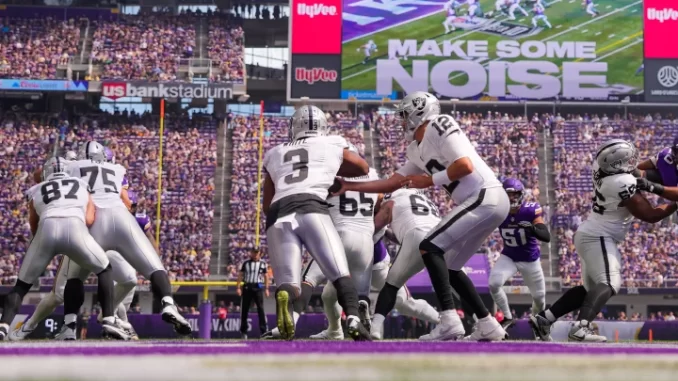
As the Las Vegas Raiders gear up for the 2024 NFL season, optimism is high among fans and analysts alike, particularly concerning the team’s running back unit. With a blend of depth and experience, the running backs room has been a point of confidence for the Raiders. Yet, a recent report from Pro Football Focus (PFF) has raised questions about the team’s faith in their ball carriers, casting a shadow over an otherwise promising preseason.

The Raiders have completed their preseason slate and are now in the process of finalizing their 53-man roster. Head Coach Antonio Pierce is already setting his sights on the Week 1 matchup against the Los Angeles Chargers, who are led by the seasoned NFL coach Jim Harbaugh. This period of preparation and roster adjustment is crucial for the Raiders as they transition from preseason to the regular season.
As fantasy football enthusiasts across the country draft their teams, Pro Football Focus, a prominent analytics company that has made significant waves in football analysis over the past decade, has shared insights on how the Raiders’ running backs could impact fantasy leagues. Nathan Jahnke, a PFF analyst, recently provided a detailed analysis of the Raiders’ running backs during the preseason, which has sparked some controversy.
Jahnke’s analysis highlighted a recurring theme: the Raiders’ apparent lack of trust in their running backs. According to Jahnke, Zamir White, who started both preseason games with the first-team offense, was frequently removed during critical situations. Jahnke noted that White was taken out for third-and-medium and third-and-long situations, even if it was his drive. Specifically, White played the first drive of the first game but was substituted for the second drive, which mixed starters and backups. In the second game, White’s usage was similarly staggered; he played on the first two drives but was pulled for the third drive, which was still largely composed of starters. White’s presence on the field was intermittent, with notable absences from the two-minute drill and the third quarter of the third game.
Jahnke also analyzed Alexander Mattison, who is projected to be the Raiders’ No. 2 running back in terms of carries. Jahnke observed that Mattison’s role was predominantly focused on third-down situations. Mattison was present for every snap on the second drive with a mix of starters and backups and was used as the third-down back for the first two drives of the second game. Despite his involvement, Mattison was pulled from several drives and did not play in the third game.

Jahnke’s report acknowledged the nature of preseason football, where teams often stagger the playing time of their starters and backups more than they would during the regular season. He noted that the Raiders rested many of their starters and key backups in the third game, which is a common practice across the league.
Given this context, the conclusion that the Raiders do not trust their running backs might seem premature. The team’s strategic decisions during the preseason could be influenced by numerous factors, including managing player health, experimenting with different lineups, and evaluating depth. The Raiders’ usage of their running backs in these scenarios may not necessarily reflect their long-term confidence or lack thereof.
As the regular season approaches, the focus will shift from preseason experimentation to the actual game plans and strategies that will define the Raiders’ approach. Whether or not the concerns raised by Jahnke will translate into the regular season remains to be seen. For now, fans and analysts alike will be watching closely to see how the Raiders’ running backs perform and how their usage evolves as the stakes get higher.
Leave a Reply